Speech Conditions and Prospects in the Housing Sector

Anthony Richards
Head of Economic Analysis Department
Address to the 4th Annual Housing Congress
Sydney –
- Audio 31.6MB
There is always significant interest in Australia in questions relating to the housing market and housing industry. And, in recent years, housing-related factors have had a significant influence on the global economy. So this Congress will be covering issues of great interest to many of us.
In my talk today, I will discuss a number of issues concerning the Australian housing sector, including housing affordability, the supply and demand for housing, and the broader macroeconomic context. I will not be commenting on the current monetary policy situation.
Let me start by noting that the Australian housing market, like the broader economy, has softened somewhat recently. But it is a sector of the economy that demonstrates quite well the differences between the Australian economy and some of the larger economies such as the United States and the United Kingdom.
The recent weakness seen in Australian housing prices has been mainly at the higher end of the market (Graph 1). Property prices in more expensive suburbs, which had risen more over the prior few years, have recently fallen noticeably. This presumably reflects the greater exposure of people in higher-priced suburbs to financial developments. While our financial markets have continued to operate better than in many other countries, falls in Australian stock prices have been similar to those elsewhere, and the wealth effects of this are likely to have impacted most in higher-priced suburbs. However, in the other suburbs, which constitute a much larger share of the total housing stock, prices declined by much less in 2008.
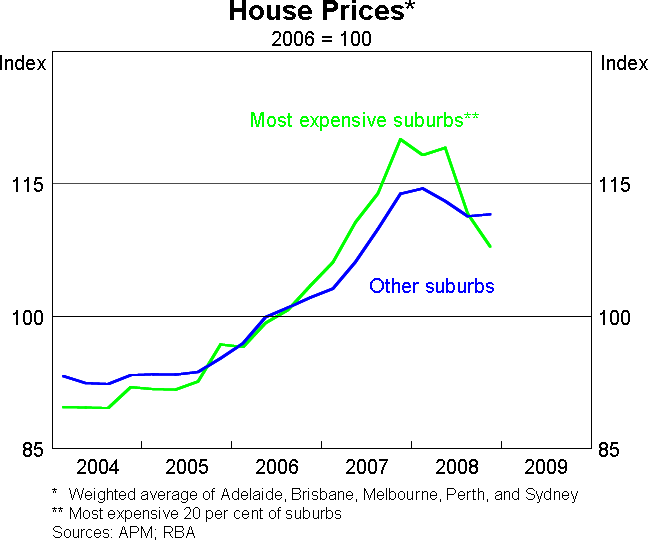
Overall, housing prices in Australia softened over 2008 by around 3 per cent. There are only very limited data for Australian prices in early 2009, but we have a preliminary gauge of the market in the auction clearance rates for Sydney and Melbourne, which have shown a significant pick-up relative to late 2008.
The modest fall in Australian housing prices in 2008 was much smaller than the double-digit falls seen (with some variations across measures) in US and UK house prices. Similarly, the falls in housing approvals and in broader measures of economic activity in Australia have been smaller than the declines seen in many other countries. Furthermore, there are a number of reasons to think that outcomes here might remain better than elsewhere. These relate both to the role of policy in responding to the downturn and the consolidation of household finances that has occurred in Australia since our housing boom slowed earlier in this decade, around the end of 2003.
I will now turn to a specific aspect of the housing market, namely housing affordability. I am going to focus on affordability for current or potential home buyers rather than on measures of affordability for renters. But the owner-occupier and rental markets are clearly linked and some of the issues I discuss today have implications for the cost of housing for renters too.
There are many complications in measuring affordability and there is no single ideal measure. However, the measure shown here is a reasonably standard one, being an index of the ratio of average household disposable income to the principal and interest repayments on a new mortgage for a median-priced dwelling (Graph 2).[1] It should be noted that measures such as this one do not incorporate the effect of grants for first-home buyers which have recently been boosted by the federal government and some states. The data in this graph go up to the December quarter of 2008 and the dot shows an estimate of this measure based on the current level of mortgage rates. It is quite clear that purchase affordability has recently improved very significantly in Australia.
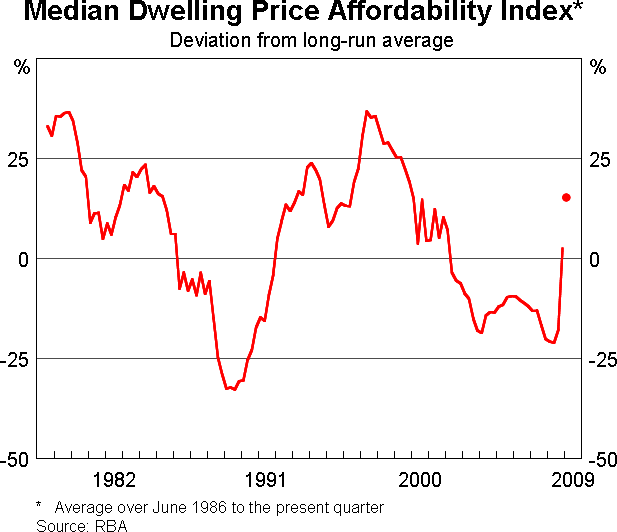
Standard affordability measures reflect the interaction of two factors: the mortgage interest rate, and the ratio of housing prices to household incomes (Graph 3). If interest rates fall, or if housing prices rise less rapidly than incomes, then affordability improves, and vice versa. The recent sharp improvement in affordability clearly mostly reflects the sharp fall in mortgage rates over the past half year.
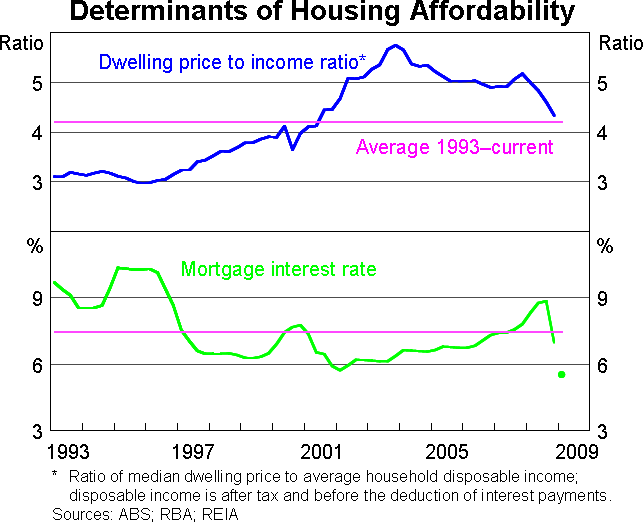
The fall in interest rates reflects the adjustment of Australian monetary policy to the decline in the outlook for the global and domestic economies. As you know, there has been a dramatic weakening in the world economy over the past half year. Average GDP growth in our major trading partners was sharply negative in the December quarter of 2008, and the March quarter of 2009 is unlikely to have been much better. As a result, monetary and fiscal policies have both been eased significantly in Australia over the past six months or so.
While there are concerns in some other countries about whether the easings in monetary policy have been especially effective, there can be no such doubt in Australia. In Australia, the cash rate has now been cut by 400 basis points since September 2008, and standard variable housing rates have fallen by 375 basis points (Graph 4). When we take an average of the interest rates paid on all housing loans (including fixed rate ones), the fall is around 265 basis points.
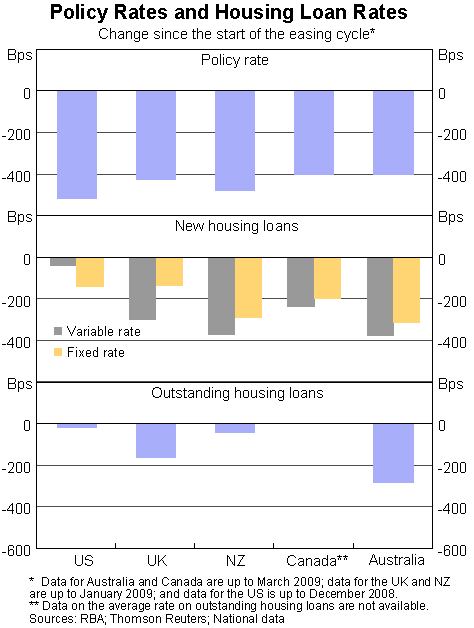
In contrast, central banks in other countries have also cut their policy rates by at least as much as the RBA, but have typically seen much smaller reductions in the actual rates paid by households and businesses.
The difference partly reflects the fact that a greater proportion of Australian borrowing is at variable interest rates than in most other countries. Furthermore, Australian banks are in healthier shape than those in most other developed economies, so they have been more able to pass through the reductions in their funding costs. The Bank's semi-annual Financial Stability Review released today provides further details on the health of the banking sector and the broader financial system.
So it is clear that monetary policy has been effective in lowering borrowing rates in the Australian economy. In aggregate terms, the fall in borrowing rates has reduced the debt-servicing burden of the household sector by approximately 5 per cent of household disposable income (Graph 5). That implies a significant amount of cash flow relief, for spending on other goods and services or to save and/or pay down debt. Admittedly, the effect on the net interest payments of the household sector – that is after we take account of the effect on the interest receipts of savers – is smaller, but there is still a significant stimulatory effect from lower interest rates.
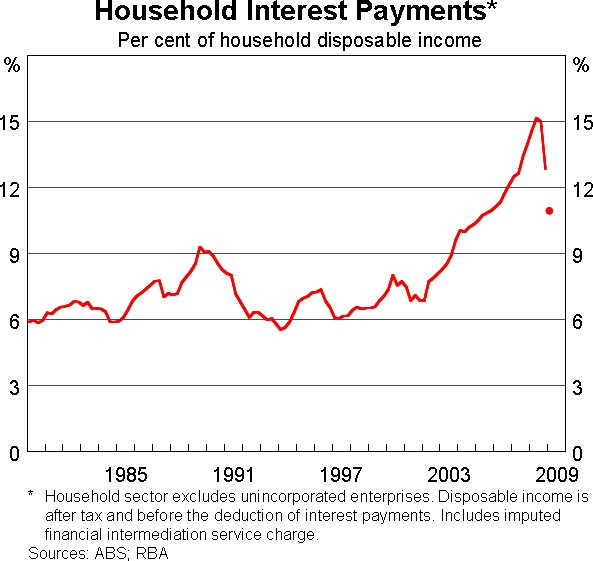
In addition to the effect on the cash flows of those who are currently making mortgage payments, the reduction in interest rates improves the accessibility of home ownership for potential home buyers, as illustrated by the earlier graph on affordability.
Of course, mortgage rates will fluctuate over time. At some point in the future – and here I am not making any comment about the current policy juncture, just making a statement about the cyclical nature of economies – interest rates will presumably be at more normal levels. So one question that we should ask is whether a period of quite low mortgage rates in Australia could lead to the type of problems that are being seen in the United States.
In the middle of this decade, the United States experienced a significant expansion of lending to higher-risk households who took out mortgages at low initial interest rates that were scheduled to reset a few years later at much higher rates. Much of this lending was premised on the expectation that housing prices would continue to rise so that the increase in equity would allow the borrower to refinance to a more conventional mortgage before the initial mortgage reset to the much higher interest rate. Of course, this type of lending was also facilitated by the ability of lenders to on-sell the mortgage to be securitised and sold into the capital markets where investors were not especially discriminating in what they would buy.
So the question arises whether a period of low interest rates in Australia (combined with the boost in grants to first-home buyers) could lead to an expansion of lending to riskier borrowers who will only be able to afford their mortgages as long as interest rates remain low. I think there are good reasons to think this is not a major risk.
Australian lending standards were never relaxed during the earlier boom as much as they were in the United States. We can illustrate this quite starkly by looking at the proportion of non-performing loans on bank balance sheets in the two countries (Graph 6). The US ratio is clearly far higher than in Australia now, but it was also significantly higher a few years ago when both economies were experiencing strong economic growth.
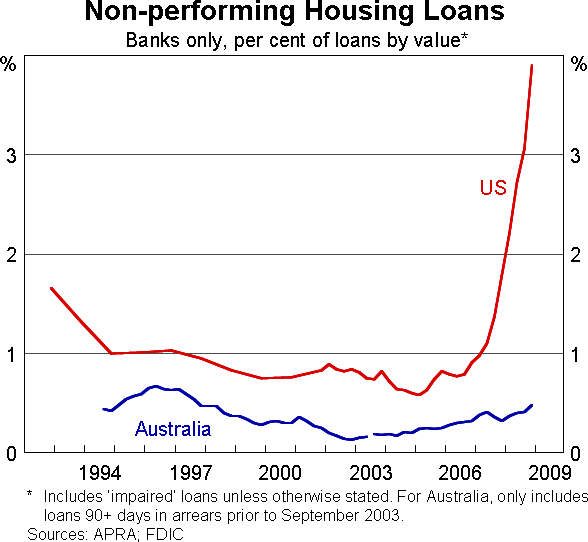
But in any case, many of the lenders that might have been most likely to write riskier loans have scaled back their activity. The past year and a half has seen lending standards tighten in Australia, with a significant shrinkage in the amount of low-doc and non-conforming lending. Most lending is now staying on balance sheet, and a greater share is being done by banks, which have tended to reduce their maximum loan-to-value ratios. Our discussions with banks indicate that they are indeed testing the ability of borrowers to continue servicing their loans if interest rates were to rise significantly.
No doubt, as at any time, some of the loans being written now will turn sour. However, overall, I suspect that the risk of non-performing loans increasing to the extent seen in the United States is low. Nevertheless, households that are considering entering into home ownership need to carefully consider their own circumstances, including whether they would be able to continue servicing their loans if mortgage rates were at some point to begin to return to more normal levels.
In addition to mortgage rates, the second determinant of standard affordability measures is the ratio of housing prices to income. At present, this ratio remains slightly above its average over the low-inflation period (Graph 3). Of course, there may be good reasons for it to have experienced a trend increase over recent decades as the economy adjusted to a structural shift to lower inflation.
But it is noteworthy that the housing price to income ratio has declined significantly since its peak in late 2003. Over the period since end 2003, nationwide house prices have grown on average by 4 per cent per annum, versus annual growth of 14 per cent in the prior five-year period. And the growth rate of house prices in the past five years has been well below the 8 per cent average annual nominal growth in household disposable incomes.
So the price-income ratio, a frequently used – but crude – measure of housing price valuation suggests that any overvaluation of housing prices has eased significantly since the Australian housing boom slowed significantly in late 2003. Since then, households have had significant income growth, but that growth has flowed only to a modest extent into housing prices.
Some other perspectives would also indicate some positive trends in household behaviour over the past five years.
In the period leading up to 2003, growth in household consumption spending ran ahead of growth in household income (Graph 7). As a result, the household saving rate declined significantly. But, since end 2003, this trend has been reversed. Households have seen strong income growth, but their growth in consumption spending has been lower. On average, annual growth in spending has run about 2½ percentage points below income growth in this period. As a result, the saving rate has risen significantly and in trend terms (which will downplay the sharp rise in the December quarter) is back at levels seen in the mid 1990s before the start of the housing boom.
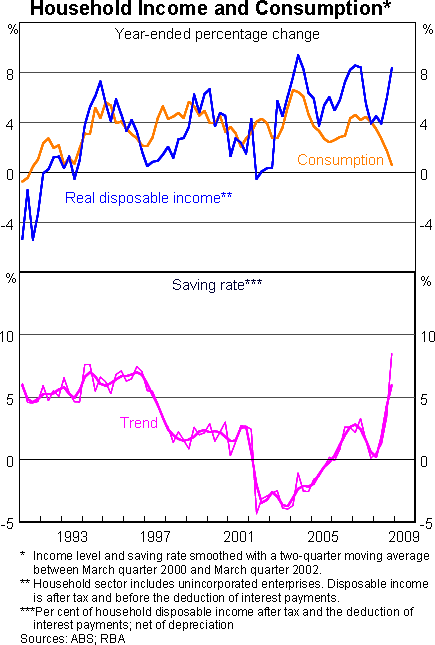
Another perspective on household behaviour can be gained from the data for housing equity injection (Graph 8). In aggregate, housing equity injection is a measure of the extent to which we have increased our net ownership of housing, abstracting from valuation effects. As we construct new housing, the dwelling stock grows. But if we increase our borrowing for housing, this reduces the amount by which we are building up equity in housing.
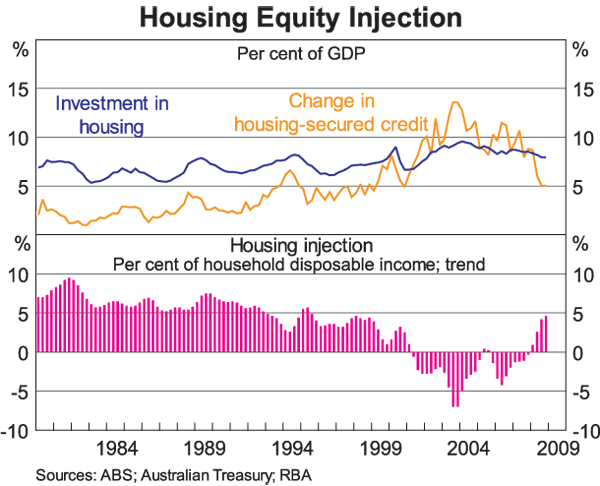
Historically, the community significantly increased its net equity in the housing stock each year. But from the mid 1990s this began to change, as the growth of housing-secured borrowing rose. This coincided with greater competition in the market for housing finance, including new products such as redraws and housing lines of credit. It was also the period when the share of investors (or buy-to-let purchasers) in new lending grew significantly. Indeed, early in this decade, growth in housing credit exceeded the value of new housing being built.
However, a reversal of this trend started around end 2003. Growth in housing credit gradually slowed over the past five years. Housing equity withdrawal gradually declined and we have now returned to the more normal state of affairs where we are again increasing our equity in the housing stock. And as the boom in the market cooled, the share of investors in approvals for housing finance has fallen from a peak of over 40 per cent in late 2003 to below 30 per cent now.
These trends in the housing price to income ratio, the household saving rate and housing equity injection illustrate some beneficial developments in household finances over the past five years. If the housing boom that was underway earlier this decade had continued, along with some of the behaviour that accompanied it, no doubt we would now be facing greater risks. But the housing boom here came to an end earlier than in many other countries, and household behaviour has changed significantly since then. As a result, our economy, and household and financial sectors have entered this global slowdown in far better shape than otherwise.
Of course, as I noted above, mortgage rates will fluctuate over time, so in the long run housing affordability will be mostly driven by the level of housing prices relative to household incomes. This brings me to the issue of supply- and demand-side factors in influencing housing prices and the broader question of supply and demand in the housing market.
I have previously suggested, as have many others, that the relatively high level of housing prices in Australia is to a large extent a reflection of demand and the collective decisions of households. That is, housing prices have not been set at high levels by some external force. They are at their current levels because buyers in aggregate – with their incomes, preferences, access to finance, and other influences – have been willing to pay those prices.
But it is also the case that supply-side factors matter, and here I define these broadly to include factors affecting the ability to build new housing on the city fringe, factors affecting the ability to expand supply closer to city centres, and factors such as community and transport infrastructure that influence the feasibility and desirability of living in different places.
The last two of these factors are hard to quantify, but one element influencing the first is the cost of raw land. We recently looked at the cost of low-priced land in new developments near the edges of our five largest cities (Graph 9). It is probably a good indicator of some of the supply issues there. Land prices are clearly still highest on the edges of Sydney and lowest on the edges of Melbourne and Adelaide.[2] Overall, prices still appear quite high given that this is supposed to be about the lowest-cost land available. It will be interesting to see whether it is possible to reduce these prices, or at least keep a lid on increases, in coming years.
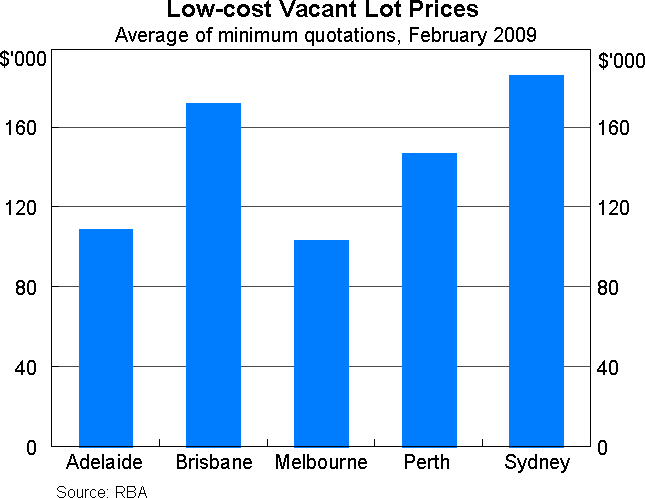
The ability to expand the supply of housing will be one of the factors that influences housing affordability over the medium term. And the performance of the home-building sector will be an important influence on economic activity over the coming period when international factors may be restraining growth in Australia.
As you will know, home-building has recently been at relatively low levels, with commencements of around 147,000 dwellings in 2008 (Graph 10). And towards the end of the year, commencements and building approvals were running at significantly lower levels than that.
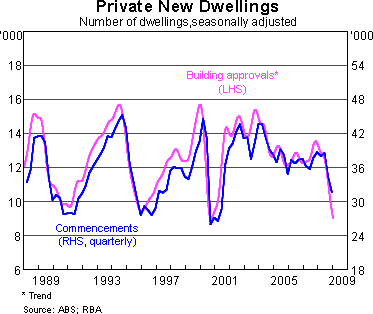
The recent weakness in housing approvals no doubt partly reflects the general slowing in the economy. When the economy is slowing and the outlook is uncertain, it would not be surprising if households and builders were more risk averse than usual. We have also seen significant weakness in purchases of motor vehicles, another large-ticket item where there is some discretion as to when purchases are made.
But within the total, approvals and commencements have slowed more for apartments than for houses. The particular weakness in apartments appears to reflect a tightening of financing. Financing for construction of apartments typically requires pre-sales of some proportion of the apartments. Banks have become more risk averse and have increased the proportion of pre-sales required. More generally, our liaison program has indicated that the tightening in the availability of business finance has been greater for firms in the property sector (especially commercial property) than in other sectors.
The recent weakness in building approvals will be reflected in further falls in construction activity over the first half of this year. Looking beyond that, there are several factors which should contribute to growth. Most importantly, the falls in interest rates and improvements in housing affordability that have occurred over the past six months have not really fed through into construction activity yet, but we can expect them to gradually boost home-building.
First-home buyer demand is also expanding following the boost to grants for these buyers. We can see this from the increase in the number of grant payments made in recent months and the rise in the share of first-home buyers in loan approvals to the highest on record (Graph 11). Much of this demand will be for existing dwellings, but we can also expect that it will gradually feed through into the data for building approvals and for building activity. We are seeing some evidence of this already in our liaison with home-builders.
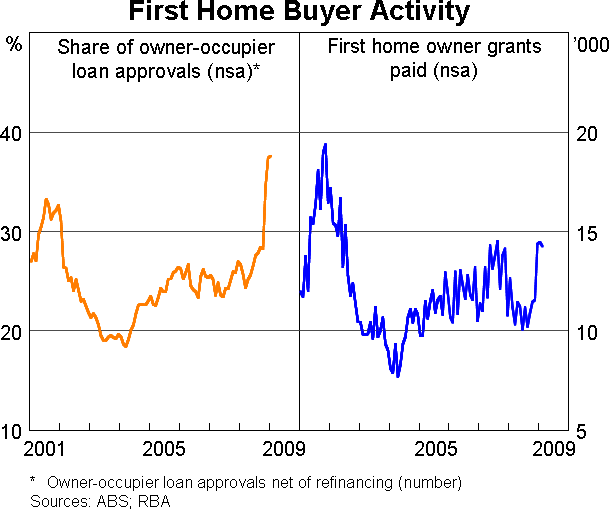
Another factor that should support home-building over the medium term is that we are starting from a position of some undersupply in the housing market. Although there is some uncertainty as to how large the undersupply is, I suspect it may be less than some of the estimates in the public domain.
The largest estimates of the cumulative undersupply are based on comparisons of actual completions in recent years with estimates of ‘underlying demand’ for housing. This figuring is essentially asking the following question: Given current population growth rates, if the decline in average household size and level of demand for second houses that has occurred over recent decades had been maintained in recent years, how many new homes would we need to build? Most calculations now put ‘underlying demand’ at something like 180,000 to 200,000 dwellings per year, which means we would have needed to build significantly more homes than has actually occurred.
However, such figuring is based on simply extrapolating earlier trends and ignores the likely impact of prices on the demand for housing. Over recent decades, the cost of housing (including land) has grown faster than incomes and the cost of many other goods and services. This reflects both demand-side factors and supply-side ones. But we might expect that, at some point, the demand for housing will be affected by the higher cost of housing. For example, with housing – both owner-occupied and renter – more expensive than in the past, we might expect to see some young adults choosing to live with their parents for longer. We might expect some households to look for an extra flatmate rather than leaving a bedroom vacant. Some owners of holiday homes or second homes might have become more inclined to sell them, with those houses then occupied full-time.
So perhaps the longer-term run-up in the cost of housing is one of the reasons that we have built fewer homes in recent years than might have been expected. Now I am not saying that there is no undersupply of housing. At the very least, one can look at estimates that the aggregate nationwide rental vacancy rate is currently around 1½ per cent versus more normal levels of around 3 per cent (Graph 12). Given a rental stock of around 2½ million dwellings, a simple calculation would imply the need for about 40,000 additional dwellings to get the rental market back closer to balance.[3]
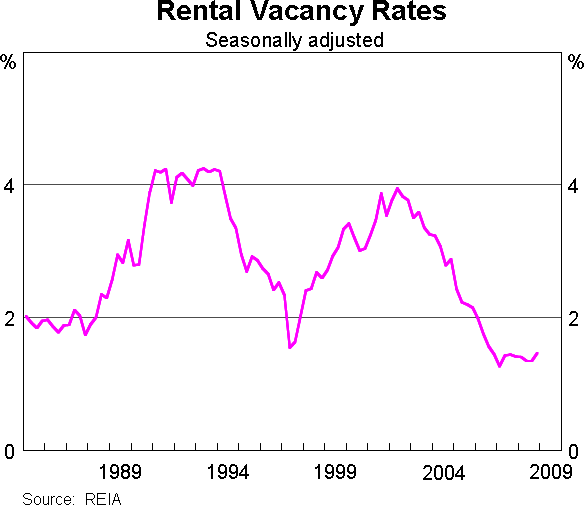
Whatever the true shortfall of dwellings, we can say with some confidence that our housing market is relatively tight. This can be contrasted with the US market which many observers characterise as having been subject to overbuilding during their housing boom. And the relative tightness of the Australian housing market is one factor that will support home-building in the period ahead.
A final influence supporting construction will be the measures that the federal government has taken to boost housing supply. Examples are the National Rental Affordability Scheme which aims to stimulate the supply of up to 50,000 new units of affordable rental housing, and the Housing Affordability Fund which will finance projects to reduce the cost of bringing new supply to market. State government measures may also help, such as the New South Wales government's reduction in infrastructure charges, especially in Western Sydney.
Policies such as these will help to support home-building activity at a time when activity in the broader economy will be subdued. They also offer the prospect of lowering the cost of housing in the medium term. Indeed, perhaps the best chance of boosting housing construction on a sustainable basis may be to seek to reduce impediments on the supply side that are either boosting the cost of building new housing on the fringes of our cities or are constraining the ability to build more housing closer to the centres of our major cities. Regardless of the broader economic factors that are currently influencing the housing market, it is important to keep thinking about medium- and longer-term reforms in the housing market that can improve the functioning of the market and potentially lower the cost of housing over the longer run, especially for lower-income groups. No doubt some of the other speakers in the Congress will speak more about these important structural issues.
So there are three main points that I would like to emphasise today.
First, the recent significant falls in the cash rate are having positive effects on the economy and the household sector, and have contributed to a significant improvement in household cash flows and in measures of housing affordability for people paying mortgages or contemplating home ownership. Second, although home-building is likely to remain weak in the near term, there are a number of factors which should support activity over the medium term, providing stimulus to the broader economy. Finally, when one looks at the behaviour of the household sector over the past five years – in particular the trends in housing prices, and household income, spending and borrowing – it is evident that there has been a significant degree of consolidation since the housing boom slowed in 2003. This will reduce the vulnerability of the household sector in the current slowdown.
Endnotes
Some other measures of affordability (for both home buyers and renters) are shown in my talk to the Melbourne Institute Conference in 2008. [1]
Looking across the cities, the prices are typically for blocks averaging 400–450 square metres in size (a little smaller for Adelaide) and about 40 kilometres from the centre of the city (about 30 kilometres for Adelaide and Brisbane). [2]
The recent National Housing Supply Council ‘State of Supply Report’ uses a similar approach to estimate undersupply, to which it adds an estimate of the number of dwellings required for the homeless and marginal residents of caravan parks. The overall estimated shortfall was around 85,000. [3]